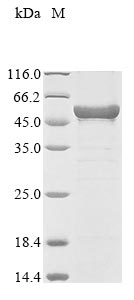Recombinant Enterobacteria phage T4 ATP-dependent DNA helicase dda is expressed in E. coli and includes both an N-terminal 10xHis-tag and a C-terminal Myc-tag for convenient purification and detection. The protein is produced as a full-length sequence covering amino acids 1 to 439. When analyzed via SDS-PAGE, it achieves a purity level exceeding 85%, which appears to ensure high-quality results for research applications.
The ATP-dependent DNA helicase dda from Enterobacteria phage T4 seems to be a key enzyme involved in DNA replication and repair processes. It functions by unwinding DNA helix structures, which facilitates the progression of replication forks and the repair of damaged DNA. This protein represents a significant tool for studying molecular mechanisms of DNA manipulation and phage biology. It may provide insight into the enzymatic actions essential for genetic material processing.
Potential Applications
Note: The applications listed below are based on what we know about this protein's biological functions, published research, and experience from experts in the field. However, we haven't fully tested all of these applications ourselves yet. We'd recommend running some preliminary tests first to make sure they work for your specific research goals.
Enterobacteria phage T4 ATP-dependent DNA helicase Dda is a complex enzyme that requires precise folding, proper ATP-binding site formation, specific DNA-binding domains, and correct tertiary structure for its functional helicase activity. The E. coli expression system is homologous to this bacteriophage protein, which significantly increases the probability of correct folding. The dual N-terminal 10xHis-tag and C-terminal Myc-tag are relatively small compared to the full-length protein (439 aa, ∼49 kDa) and may cause minimal steric interference. While the full-length protein contains all functional domains, the probability of correct folding with functional helicase activity requires experimental validation of DNA unwinding capability and ATPase activity.
1. In Vitro DNA Helicase Activity Assays
This application carries a significant risk without functional validation. Dda helicase activity requires precise ATP-binding site formation, proper DNA-binding domains, and correct tertiary structure. If correctly folded and active (verified through DNA unwinding and ATPase assays), the protein is suitable for mechanistic studies. If misfolded/inactive (unverified), helicase activity measurements will yield biologically meaningless results. The tags may sterically interfere with DNA binding or processive movement.
2. Protein-DNA Interaction Studies
This application requires proper folding validation. Dda-DNA interactions require precise DNA-binding domain formation and proper tertiary structure. If correctly folded (verified through EMSA or binding assays), the protein may characterize DNA binding specificity; if misfolded/unverified, there is risk of non-specific binding or failure to replicate genuine helicase-DNA interactions.
3. Antibody Development and Validation
This application is highly suitable as antibody development relies on antigenic sequence recognition rather than functional protein folding. The full-length protein provides comprehensive epitope coverage for generating Dda-specific antibodies. The high purity (>85%) ensures minimal contamination-related issues during immunization protocols.
4. Protein Pull-Down and Interaction Mapping
This application carries a moderate risk without folding validation. Dda interactions with replication machinery components require native conformation. If correctly folded (verified), the protein may identify physiological interaction partners; if misfolded/unverified, there is a risk of non-specific binding or tag-mediated artefacts.
5. Comparative Helicase Structure-Function Studies
Meaningful comparative studies require native enzyme conformation and functional activity. If correctly folded and active (verified), the protein enables valid evolutionary and functional comparisons with other helicases; if misfolded/inactive (unverified), comparative analyses would yield misleading insights about helicase conservation and mechanism.
Final Recommendation & Action Plan
The E. coli-expressed T4 Dda helicase with dual tags has a high probability of correct folding due to the homologous expression system, but experimental validation of helicase activity is crucial. Begin with functional validation using DNA unwinding assays (e.g., with forked DNA substrates) and ATPase activity measurements to confirm functionality. Applications 1, 2, 4, and 5 require this validation before proceeding. Application 3 (antibody development) can proceed immediately. The small size of the tags relative to the large protein (49 kDa) minimizes interference concerns. For reliable Dda research, validate specific helicase activity and DNA binding capability before functional applications, and consider including appropriate controls for tag interference in critical experiments.






